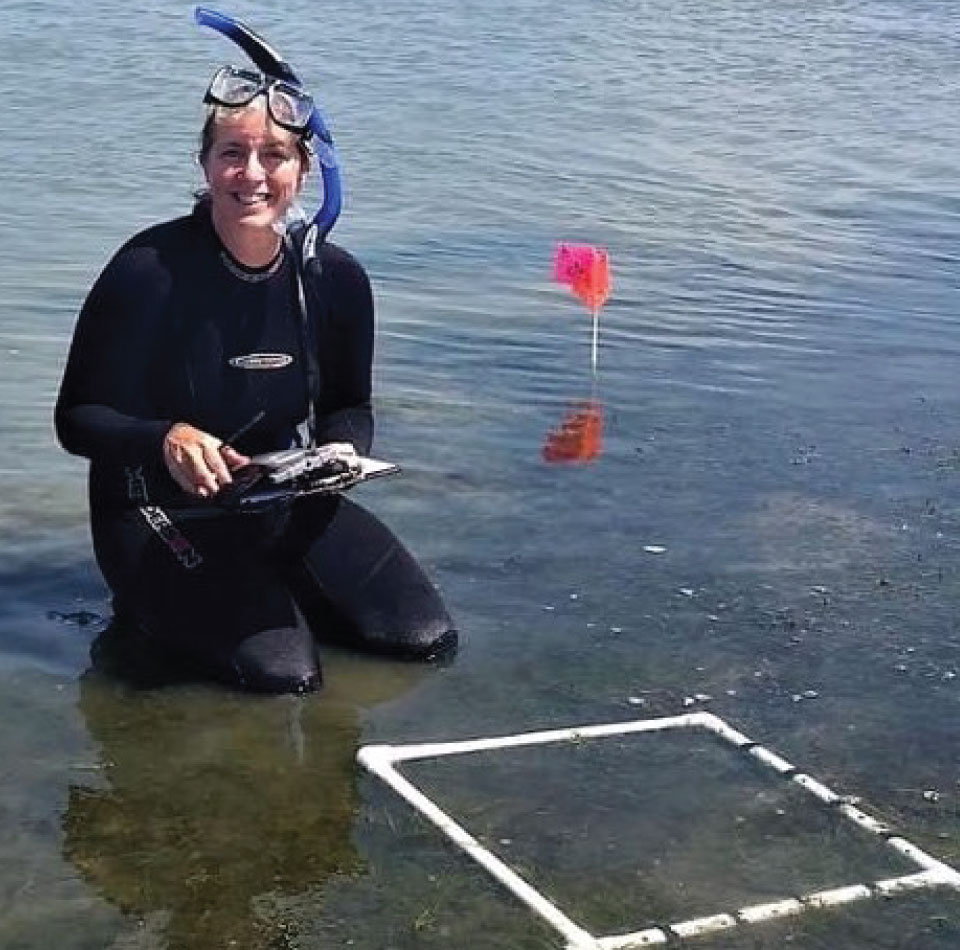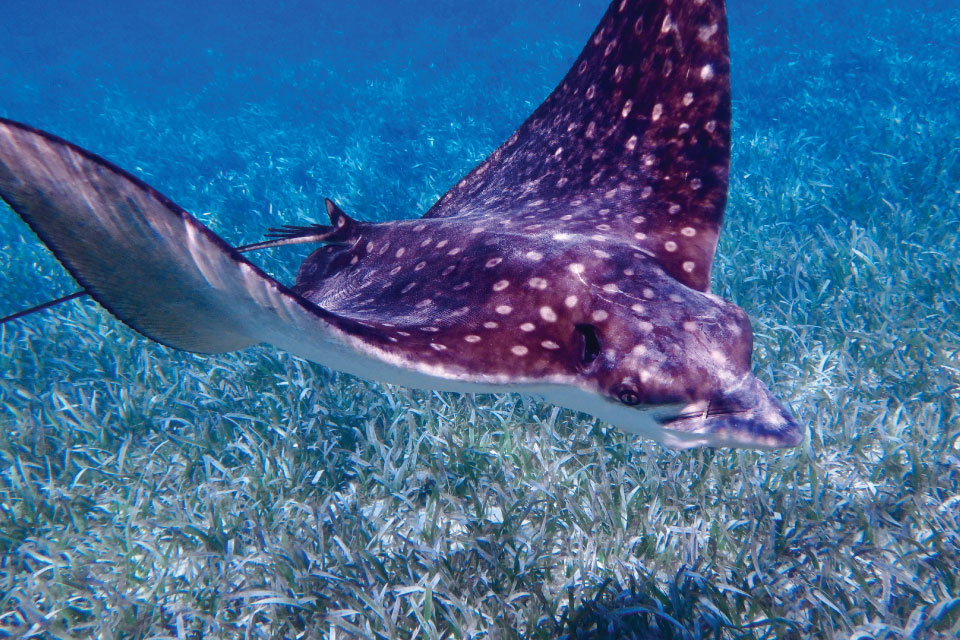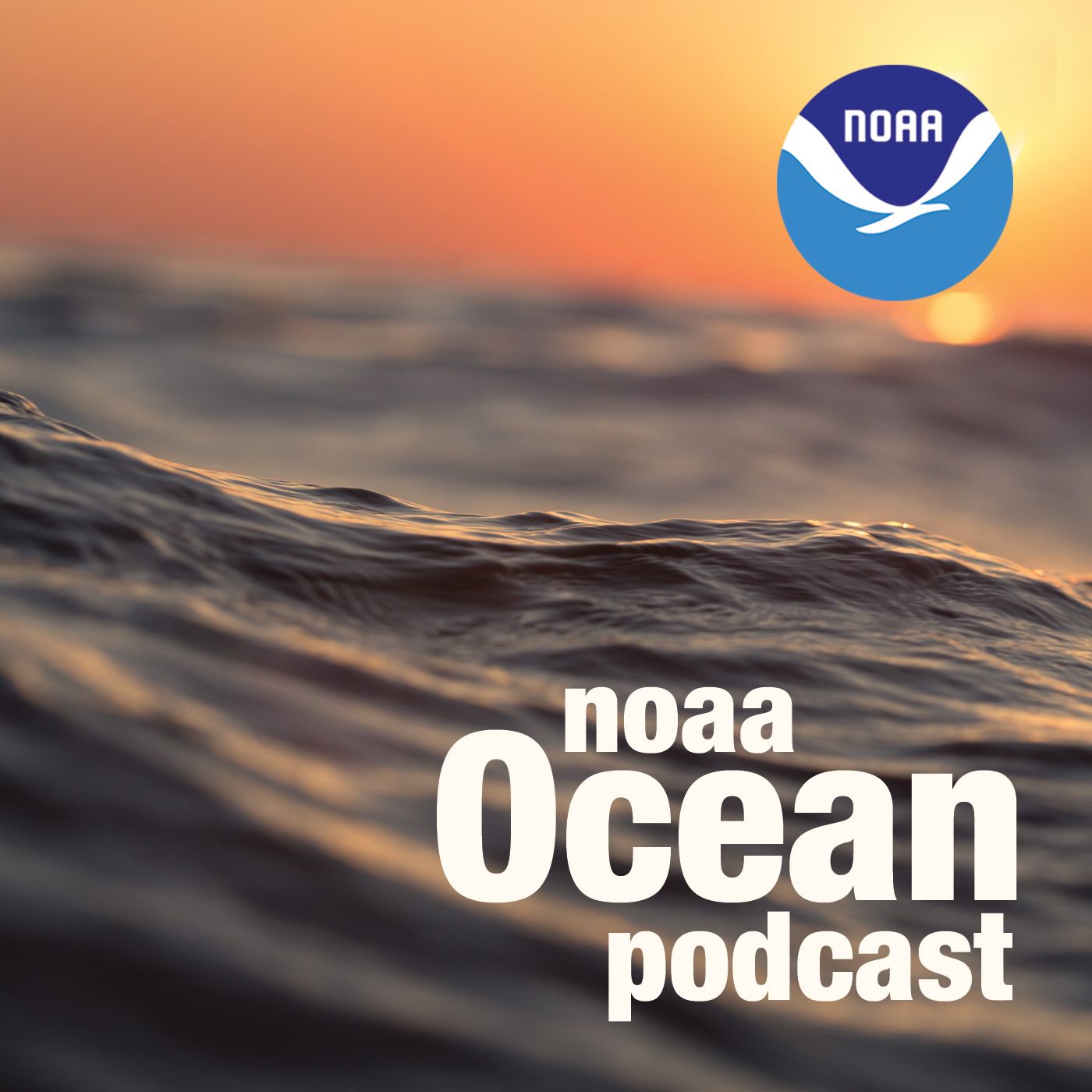Seagrass: Ecosystem Services Provider
NOAA Ocean Podcast: Episode 63
Seagrasses are plants that grow in semi salty water to full seawater in the intertidal and subtidal zones of the ocean. As one of the most productive ecosystems in the world, seagrasses offer myriad benefits to both humans and the organisms that call them home. In this episode, we explore some of the ecosystem services they offer.

Seagrass meadows can grow large enough to be seen from space. Pictured here is a bed of manatee seagrass in the Florida Keys National Marine Sanctuary.
Listen here:
Or listen in your favorite podcast player:
Transcript
HOST: This is the NOAA Ocean Podcast, I’m Marissa Anderson. Here’s a brain teaser for you. What organism is considered to be the oldest living on Earth, can be large enough to be seen from space, and is sometimes referred to as, the lungs of the sea? If you answered, seagrass, you are correct! In this podcast, we interview Dr. Amy V. Uhrin, chief scientist of NOAA’s Marine Debris Program and seagrass expert. Let’s dive right into our discussion as Amy provides us with some fast facts on these impressive plants.

Dr. Amy V. Uhrin, Chief Scientist, NOAA’s Marine Debris Program
UHRIN: Seagrasses are rooted flowering plants that grow in semi salty water to full seawater in the intertidal and subtidal zones of the ocean. They live entirely submerged under the water’s surface, and they evolved from terrestrial plants that migrated back to the ocean many millions of years ago. Seagrass plants have stems, leaves, roots, and — just like land plants — they are capable of photosynthesis, but despite looking like land grasses, seagrasses are actually more closely related to lilies and ginger plants. And there are 72 species of seagrass globally. Seagrasses can cover large areas of the seafloor, forming what we call beds or meadows and, in fact, some seagrass meadows are large enough to be seen from space, which is really cool. Seagrass ecosystems provide habitat for hundreds of species, and they’re among the most productive ecosystems in the world. Using DNA sequencing, a patch of seagrass off the coast of Spain has been identified as the oldest living organism on Earth. Some of the plants in that particular patch were found to be 80,000 and 200,000 years old, which is staggering.
HOST: Now you mentioned the ecosystems of seagrass, are there specific areas where they typically thrive? Do they prefer warmer climates, colder, or does it not really matter?
UHRIN: So seagrasses actually occur in tropical, subtropical, temperate and polar climates. They’re found along the shorelines of every continent except Antarctica, and their distribution is in abundance, so where they occur along the shore is largely controlled by light availability. So I mentioned before that they photosynthesize, so they need to have light. So they are most commonly found in shallow, coastal waters and they typically occur in areas that are sheltered from high winds and waves and areas that have muddy or sandy sediments.
HOST: So you actually kind of led into my next question. I was gonna ask, why are seagrass considered to be important for the health of the ocean, and you kind of touched on that, could you explain a little bit more in detail?
UHRIN: Yeah, absolutely, they are really important. They actually provide many different types of ecosystem services, so an ecosystem service is the benefit that humans gain from the natural environment. So I mentioned previously that seagrasses do provide critical habitat, refuge, and feeding areas for many important animals, including a number of species that are commercially important for seafood like crabs, scallops, shrimp, flounder, so of course, if you like seafood, you are benefiting from the seagrass helping out those critters during their lifecycle. The seagrass canopy can reduce the energy from waves and tides that's flowing over the grass and trapping fine sediment that accumulates. So this protects shorelines from erosion, kind of creates a buffer if you will, if storms pass through and there are some other services that seagrass provides to us that are not so obvious because they are nonmaterial benefits. These are things or benefits that people would gain simply by interacting with the environment; in this case, interacting with the seagrass; for example, perhaps if you are like me and enjoy snorkeling in a seagrass bed and seeing all the cool critters that hang out there. So that’s another type of benefit from seagrasses. And lastly, seagrasses also contribute to the most basic cycles that marine ecosystems need to function. For example, seagrasses use and recycle nutrients from both the water column and the sediments, and they release oxygen into the water which is why they are sometimes called the “lungs of the sea.”
HOST: So it sounds like seagrass has a pretty big job to do.
UHRIN: Yeah, they tackle a lot.

Seagrass meadows provide critical habitat, refuge, and feeding areas for many organisms. In this image, a spotted eagle ray cruises over turtle grass in the Meso American Reef in Belize.
HOST: I think you had touched on this a little bit, too previously, but how does seagrass help lessen the impacts of climate change?
UHRIN: This is a really good question. It’s an area of research that is gaining traction and has for, like, the last five to ten years. But to talk about how seagrass can help with climate change, let me just first talk about what climate change is generally. When greenhouse gasses like carbon dioxide are released into the atmosphere in increasing quantities, they can trap the heat from the sun, which can lead to long-term shifts in temperature and weather patterns. Now, the ocean absorbs a lot of these carbon dioxide emissions from the atmosphere on the order of around 25% of all carbon dioxide emissions from the atmosphere. Although this can help limit climate change, it's not particularly good for marine ecosystems cuz too much carbon dioxide in the ocean decreases the pH of the water and makes it more acidic, and this is called ocean acidification, and its a problem for sea life if they have hard skeletons like corals and who have shells, like oysters that are made of calcium carbonate. These structures can actually dissolve if the pH of the water becomes too low and the water becomes too acidic. Q ue the seagrasses, right? The seagrasses have significant potential for storing carbon, both through the uptake of carbon dioxide from the water, which they use in photosynthesis and also by storing organic carbon in their tissues, in their below-ground roots and rhizomes and also trapping organic carbon in the surrounding sediments. And even the seagrasses cover only about 2/10 of the sea floor, they account for about 10% of all carbon that’s buried at sea each year, and its actually been estimated that seagrasses store twice the amount of carbon per square kilometer of vegetation compared to terrestrial forests, so that’s pretty impressive. For this reason, conserving and restoring seagrass meadows on a large scale is often suggested as an actual solution to offset carbon dioxide emissions and help reduce the impacts of climate change.
HOST: Wow, that is pretty amazing! Can seagrasses also protect local communities by acting as a buffer against, say, storm surge or flooding?
UHRIN: Yes, exactly, the canopies can trap sediment, cause it to accumulate, which actually creates more habitat for the seagrasses themselves to expand and create larger meadows so you have more of this vegetative area in the coastal zone, you have more of that wave- dampening capacity because you’ve got all the leaves and the blades up in the water column reducing the wave energy coming in from a storm or high currents passing by a coastal area, so yes for sure they can help mitigate some of that energy and cause less effects on land, say, than if the waves hit like full force on the coast.
HOST: This is the NOAA Ocean Podcast. Thanks for listening. Be sure to check out our show notes to learn more about seagrass and the benefits they provide. Subscribe to us in your favorite podcast player so you never miss an episode.

From corals to coastal science, connect with ocean experts to explore questions about the ocean environment.
Social